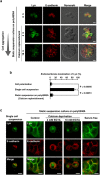Recruitment of Lyn from endomembranes to the plasma membrane through calcium-dependent cell-cell interactions upon polarization of inducible Lyn-expressing MDCK cells
- PMID: 28352128
- PMCID: PMC5428707
- DOI: 10.1038/s41598-017-00538-5
Recruitment of Lyn from endomembranes to the plasma membrane through calcium-dependent cell-cell interactions upon polarization of inducible Lyn-expressing MDCK cells
Abstract
Src-family kinases, expressed in a wide variety of cell types, are anchored to cellular membranes through posttranslational lipid modifications and involved in diverse cellular signalling. In epithelial cells, Src-family kinases are localized at the plasma membrane and participate in epithelial functions. Epithelial cell polarity is achieved through dynamic reorganization of protein trafficking. To examine the trafficking of Src-family kinases between polarized and non-polarized epithelial cells, we generated an MDCK cell line that can inducibly express a protein of interest in a polarized state at any time. We show here that Lyn, a member of Src-family kinases, mainly localizes to the plasma membrane in polarized MDCK cells and to endomembranes in non-polarized MDCK cells. Cell-cell interactions between adjacent MDCK cells recruit Lyn from endomembranes to the plasma membrane even without cell attachment to extracellular matrix scaffolds, and loss of cell-cell interactions by calcium deprivation relocates Lyn from the plasma membrane to endomembranes through Rab11-mediated recycling. Therefore, using our MDCK cells expressing inducible Lyn, we reveal that calcium-dependent cell-cell interactions play a critical role in plasma membrane localization of Lyn in polarized MDCK cells.
Conflict of interest statement
The authors declare that they have no competing interests.
Figures







Similar articles
-
Role of Membrane Cholesterol Levels in Activation of Lyn upon Cell Detachment.Int J Mol Sci. 2018 Jun 19;19(6):1811. doi: 10.3390/ijms19061811. Int J Mol Sci. 2018. PMID: 29921831 Free PMC article. Review.
-
Rab10 regulates membrane transport through early endosomes of polarized Madin-Darby canine kidney cells.Mol Biol Cell. 2006 Jul;17(7):3156-75. doi: 10.1091/mbc.e05-08-0799. Epub 2006 Apr 26. Mol Biol Cell. 2006. PMID: 16641372 Free PMC article.
-
Rapid trafficking of c-Src, a non-palmitoylated Src-family kinase, between the plasma membrane and late endosomes/lysosomes.Exp Cell Res. 2007 Jul 15;313(12):2651-66. doi: 10.1016/j.yexcr.2007.05.001. Epub 2007 May 8. Exp Cell Res. 2007. PMID: 17537435
-
Definition of distinct compartments in polarized Madin-Darby canine kidney (MDCK) cells for membrane-volume sorting, polarized sorting and apical recycling.Traffic. 2000 Feb;1(2):124-40. doi: 10.1034/j.1600-0854.2000.010205.x. Traffic. 2000. PMID: 11208093
-
Recycling of galectin-3 in epithelial cells.Eur J Cell Biol. 2015 Jul-Sep;94(7-9):309-15. doi: 10.1016/j.ejcb.2015.05.004. Epub 2015 Jun 1. Eur J Cell Biol. 2015. PMID: 26059399 Review.
Cited by
-
Role of Membrane Cholesterol Levels in Activation of Lyn upon Cell Detachment.Int J Mol Sci. 2018 Jun 19;19(6):1811. doi: 10.3390/ijms19061811. Int J Mol Sci. 2018. PMID: 29921831 Free PMC article. Review.
-
Src family kinases (SFKs) and cell polarity in the testis.Semin Cell Dev Biol. 2018 Sep;81:46-53. doi: 10.1016/j.semcdb.2017.11.024. Epub 2017 Dec 6. Semin Cell Dev Biol. 2018. PMID: 29174914 Free PMC article. Review.
-
Control of atypical PKCι membrane dissociation by tyrosine phosphorylation within a PB1-C1 interdomain interface.J Biol Chem. 2023 Jul;299(7):104847. doi: 10.1016/j.jbc.2023.104847. Epub 2023 May 20. J Biol Chem. 2023. PMID: 37211093 Free PMC article.
References
-
- Brown MT, Cooper JA. Regulation, substrates and functions of src. Biochim. Biophys. Acta. 1996;1287:121–149. - PubMed
Publication types
MeSH terms
Substances
LinkOut - more resources
Full Text Sources
Other Literature Sources
Research Materials
Miscellaneous

